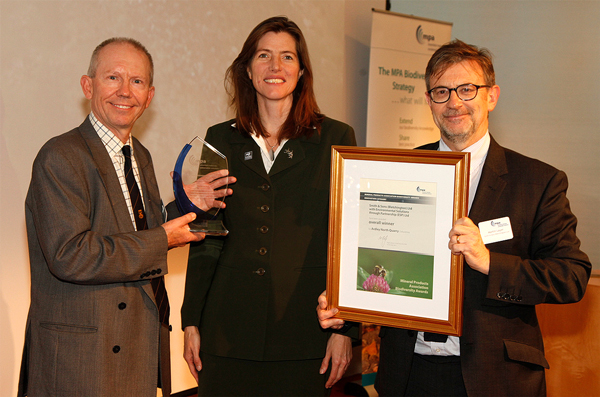Awards and Achievements
Ardley North Award
Smiths Ardley North Quarry wins top Biodiversity Innovation Award from the Mineral Products Association.
MPA Restoration and Biodiversity Awards 2013

Courtesy of the Mineral Products Association
On Wednesday 16 October 2013, the Mineral Products Association (MPA) held its prestigious Restoration and Biodiversity Awards at the Royal Society in London.
The event, which had the theme 'Realising the Potential...Progress and Partnership', celebrated the excellent work MPA member companies are undertaking, showcasing some of the best examples of quarry restoration and wildlife conservation anywhere in Europe.
DEFRA Minister, Lord de Mauley, paid tribute to the industry for its biodiversity work, along with several other speakers from conservation groups who highlighted the value of working in partnership. These speakers included Stephanie Hilborne OBE, Chief Executive of The Wildlife Trusts; Paul Lambert, Executive Director, Natural England; Gill Perkins, Conservation Manager, Bumblebee Conservation Trust; and Jeremy Biggs, Director, Freshwater Habitats Trust.
A full room of almost 200 delegates attended the event, which comprised over 50 environmental and other stakeholder organisations, along with those from industry, Government departments, academia and local authorities. Sybil Ruscoe, an experienced journalist most recently associated with the BBC Radio 4 Farming Today programme, expertly hosted the proceedings, where live presentations were complemented by on-screen video footage of the winning sites. The sponsors’ exhibition provided an excellent arena for networking before and afterwards.
The longstanding MPA Restoration Awards were announced alongside the MPA Biodiversity Awards, with the latter divided into three categories: Landscape Scale Restoration, in association with Natural England; Innovation; and Individual Contribution.
You can find out more about our award by watching MPA's video here.
Smith & Sons (Bletchington) Ltd / Environmental Solutions through Partnership (ESP) Ltd
Location: Oxfordshire
Ardley North Quarry was operated by Smith & Sons (Bletchington) Limited from 2004 until limestone aggregate extraction ceased in 2010.
In recognition of the site’s geological heritage, which includes two Geological Sites of Special Scientific Interest (SSSI), the initial restoration objectives were altered to conserve and enhance these features, whilst proactively seeking to increase biodiversity. The Ardley Trackway’s SSSI is a layer of rock strata beneath the quarry floor, imprinted with dinosaur footprints. The Ardley Cutting SSSI is a limestone exposure formed by the railway, located adjacent to the site. By working closely with Natural England, both SSSIs have been preserved for future generations to appreciate.
Smiths and their landscape consultants, ESP Ltd, used Pond Conservation’s ‘Aggregates Pond Creation Toolkit’ (now know as the Freshwater Habitats Trust) to adapt their restoration scheme in 2009. This included creating a series of overflowing ponds, which not only attenuate surface water and reduce erosion, but also enhance biodiversity. The ponds vary in profile, from shallow gradated shorelines to rocky faces, from permanent water to seasonally dry islands and shores. These features create a diversity of aquatic and marginal habitats for a range of potential species, including invertebrates, crustaceans (such as the white-clawed crayfish), wildfowl and waders. Importantly, the ponds feed into a wider aquatic network through a specially created rock weir, cut into the limestone ridge of the geological SSSI with the permission of Natural England. This allows water to flow into the adjacent site’s pools known to support colonies of Great Crested Newts, developing new habitat linkages.
The brash side slopes of the quarry have been left to naturally regenerate and the upper parts of the quarry floor restored and seeded to unimproved pasture. Furthermore, a nearby badger’s sett has been monitored and preserved during the restoration to prevent disturbance to foraging grounds.
